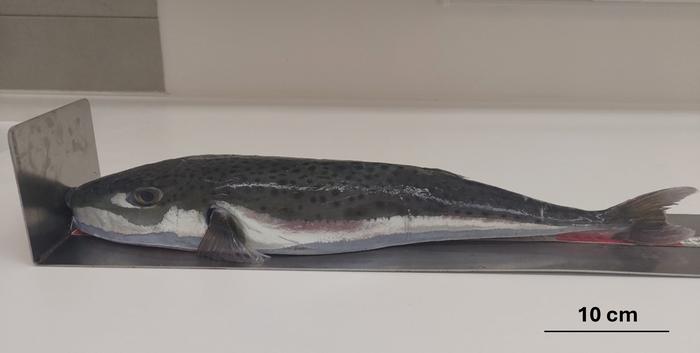Researchers have made a significant breakthrough regarding the invasive silver-cheeked toadfish, scientifically known as Lagocephalus sceleratus. This species has been documented in the northernmost part of the Mediterranean, specifically recorded in the Bay of Medulin, Croatia. This discovery raises substantial concerns regarding the implications for marine biodiversity, local fisheries, and the coastal tourism industry. Such findings reflect an alarming trend in the range expansion of this species and highlight the potential ecological consequences that may ensue as a result.
The specimen captured was a 522 mm male toadfish, weighing 1330 grams, taken from a depth of 19.7 meters on May 13, 2024. The presence of this fish in the northern Adriatic marks the fourth confirmed sighting of Lagocephalus sceleratus in the Adriatic Sea and notably the first from its northernmost waters. Its appearance in this region is both fascinating and troubling, given the notorious reputation of the silver-cheeked toadfish as a harmful invasive species.
Lagocephalus sceleratus is indeed notorious for its impact on local ecosystems and human safety. Its beak-like jaws are exceptionally powerful, presenting a risk not only to marine life but also to people who might come into contact with the species. Reported incidents of bites have resulted in severe injuries, including partial amputations, underscoring the serious threats posed by this invasive fish. Furthermore, the flesh and organs of this species contain a potent neurotoxin known as tetrodotoxin. Even a small amount of this toxin can be deadly if ingested, which adds an additional layer of danger for both fishermen and the general public.
The silver-cheeked toadfish has also carved out a niche in the catch of small-scale fisheries across the Mediterranean. Unfortunately, it is often associated with damage to fishing gear, posing an economic threat to local fishing industries. The analysis of the fish’s stomach contents illustrates its diet primarily consists of bivalves, gastropods, and sea urchins. This feeding behavior suggests that Lagocephalus sceleratus may disrupt the ecological balance of the Adriatic Sea, further compounding the challenges faced by local marine ecosystems.
As a Lessepsian migrant, Lagocephalus sceleratus has successfully traversed through the Suez Canal, making its way from the Indo-Pacific region to the Mediterranean. This species first emerged in the Mediterranean in 2003, and its proliferation has revealed an aggressive adaptability, allowing it to thrive in new environments. Its continued spread poses a significant risk to native marine biodiversity and necessitates urgent attention from marine biologists and environmental policymakers alike.
Dr. Neven Iveša, a co-author of the recently published study, emphasized the importance of this finding. He stated that the presence of the silver-cheeked toadfish in the northern Adriatic signals the expanding range of the species and its potential ecological and economic implications. This serves as a warning to the scientific community and local governments to adopt proactive monitoring and management strategies to mitigate the risks associated with this invasive species.
The research team strongly recommends measures such as increased monitoring efforts, regulatory actions, and public awareness campaigns that directly address the threats posed by Lagocephalus sceleratus. Educating local fishers and the general public about recognizing this species, as well as its proper handling and reporting methods, could be instrumental in managing its impact. Furthermore, the team advocates for targeted removal efforts that would help control the population and assist in early detection strategies.
The ongoing research is critical not only in monitoring the spread of Lagocephalus sceleratus but also in understanding its ecological impact within the Mediterranean marine environment. Future investigations should focus on comprehensive ecological studies aimed at detailing the interactions of this species with native marine life, thereby equipping local authorities with the data needed to formulate effective management policies.
As researchers continue to explore these dimensions, collaboration between scientific institutions, local fishers, and governmental bodies will be essential in addressing the challenges posed by invasive species like the silver-cheeked toadfish. The ecological integrity of the Mediterranean and the livelihood of communities dependent on its resources hinge on the success of these collaborative efforts.
In addition to monitoring efforts, public education remains a cornerstone of effective management. Establishing educational programs aimed at teaching local communities about the dangers associated with Lagocephalus sceleratus is vital in reducing risks related to accidental encounters. Reinforcing the notion of reporting sightings could also facilitate timely responses, helping to protect both human safety and marine biodiversity.
The publication of this research stands as a testimony to the dedicated work of scientists and higher education institutions committed to understanding and combating the threats posed by invasive species. The insights gained not only contribute to scientific knowledge but also serve as a rallying point for community action and policy enhancements aimed at safeguarding fragile ecosystems facing unprecedented threats.
In conclusion, the discovery of the silver-cheeked toadfish in the northern Adriatic underlines an urgent need for increased vigilance and action within Mediterranean fisheries and coastal tourism sectors. With its ability to disrupt local ecosystems and the tangible risks it presents to public safety, understanding and managing the implications of this invasive species must be a shared priority among researchers, policymakers, and local communities alike.
Subject of Research: Invasive Species Impact on Marine Biodiversity
Article Title: Northernmost Mediterranean record of the silver-cheeked toadfish, Lagocephalus sceleratus
News Publication Date: TBD
Web References: Acta Ichthyologica et Piscatoria
References: Iveša N, Buršić M, Dulčić J (2025)
Image Credits: Iveša et al.
Keywords: Lagocephalus sceleratus, invasive species, Mediterranean, marine biodiversity, ecological impact, tetrodotoxin, fisheries, public safety




